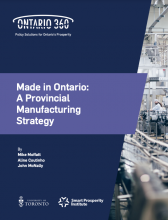Executive Summary
This paper addresses a straightforward question: “Should the Ontario government specifically try to create growth in the manufacturing sector, or should it simply focus on creating the best possible environment for business, and be indifferent to which sectors grow?” Our answer: Manufacturing matters greatly for Ontario, and the province should engage more through supportive policies and partnerships to ensure that Ontario remains Canada’s manufacturing hub.
Our reasoning is as follows:
Manufacturing is a source of growth and employment, particularly in mid-sized cities and smaller communities: Other fast-growing sectors, such as finance and professional services, tend to cluster in large cities, whereas manufacturing often performs well in mid-sized and smaller communities. Simply trying to grow the economy as a whole may concentrate employment growth in and around Toronto and Ottawa, causing slow-to-no growth in communities that are not proximate to these cities. Policymakers should view a manufacturing agenda as part of a larger economic strategy to help the growth of mid-sized and smaller communities across Ontario. This will ensure that the benefits of economic growth are more evenly distributed, and that well-paying, middle class jobs are available across the province.
Manufacturing creates benefits, like jobs and investment, for the entire community: Manufacturing has a great potential to stimulate employment across the entire economy, as well as innovation spillovers into other sectors. As a common saying goes, “a new manufacturing plant in a town will attract a Wal-Mart, but a new Wal-Mart will not attract a manufacturing plant.”
Manufacturing makes us better prepared to face a crisis: Having a robust manufacturing sector allows for the production of needed supplies during an emergency, improving regional resilience, as evidenced by the coronavirus pandemic.
Manufacturing can create jobs making cleaner, less polluting technologies: The world is about to embark on a cleantech revolution, as countries race to hit net-zero emissions. This is a massive economic opportunity to redesign Ontario’s manufacturing and competitive advantage. Ontario can contribute by not just reducing emissions, but by paving the road to a “race to the top” which will encourage our trading partners to also reduce emissions. A viable pathway for clean economic growth is by designing and manufacturing the technologies necessary in a net-zero world.
There are several policy approaches the Ontario government could take to revitalize the manufacturing sector. To capture existing comparative advantages, the Ontario government will need to thoughtfully and meaningfully partner with industry and other economic actors in supporting the revitalization of Ontario manufacturing. Efforts to revitalize the manufacturing sector and to build up productive capacity must account for the needs and challenges faced by particular regional economies. Policymakers should design and implement targeted policies to better support high value-added manufacturing in a changing global economy.
The best available path is to develop and implement policies that are tailored to the manufacturing sector. These policies must also be geographically sensitive, as the manufacturing sector performs differently in different communities. Despite the necessity for customizable policies and solutions, some general recommendations should be considered in all scenarios:
- Policymakers should run ongoing and meaningful consultations with manufacturers and stakeholders across each region of the province to better develop policies especially designed to address the needs and challenges of specific communities.
- The revitalization of manufacturing will depend on a highly skilled workforce. It is important to invest in the upskilling of manufacturing workers, especially in those soft skills that tend to be overlooked in educational curricula, but that remain important to support Ontario’s advanced manufacturing.
- It is absolutely necessary to diversify the manufacturing workforce by implementing policies and programs that remove structural barriers to the full economic participation and advancement of untapped potential.
More specifically, this paper recommends the following policy prescriptions:
- To aid the growth of manufacturing start-ups, the provincial government should create an investor tax credit to generate more support for start-ups and to help the sector attract more risk capital.
- To attract foreign direct investment and aid the scale-up of domestic companies, the provincial government should institute deep, targeted, time-limited, corporate tax cuts, for manufacturing subsectors deemed to be of strategic importance.
- To strengthen Ontario’s manufacturing ecosystem as a whole, the provincial government should translate successful policies from both the Manufacturing USA Institute model and NextGeneration Innovation Supercluster into provincial policy.
READ THE POLICY BRIEF: Made in Ontario: A Provincial Manufacturing Strategy



